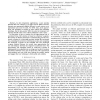505 search results - page 10 / 101 » Efficient Temporal Join Processing Using Indices |
SIGMOD
1997
ACM
13 years 11 months ago
1997
ACM
The Partitioned Based Spatial-Merge Join (PBSM) of Patel and DeWitt and the Size Separation Spatial Join (S3 J) of Koudas and Sevcik are considered to be among the most efficient ...
ICDE
2008
IEEE
14 years 8 months ago
2008
IEEE
In data integration applications, a join matches elements that are common to two data sources. Often, however, elements are represented slightly different in each source, so an app...
ICDE
2008
IEEE
14 years 8 months ago
2008
IEEE
Content-based retrieval of spatio-temporal patterns from human motion databases is inherently nontrivial since finding effective distance measures for such data is difficult. These...
SIGMOD
2009
ACM
14 years 7 months ago
2009
ACM
In the rank join problem we are given a relational join R1 1 R2 and a function that assigns numeric scores to the join tuples, and the goal is to return the tuples with the highes...
SIGMOD
2005
ACM
14 years 7 months ago
2005
ACM
XML documents are normally stored as plain text files. Hence, the natural and most convenient way to update XML documents is to simply edit the text files. But efficient query eva...

